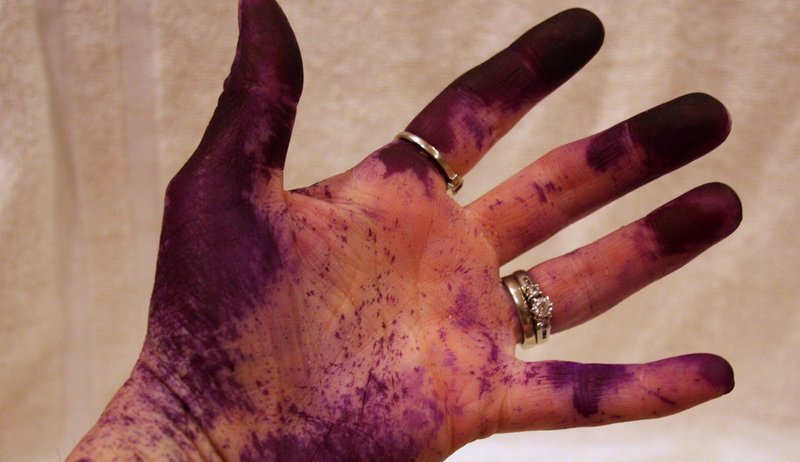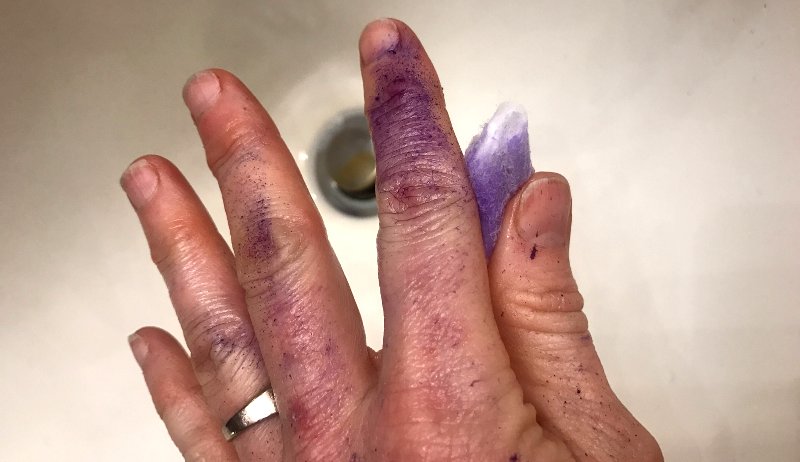
Hands stained purple—they’re a sign of solidarity, an indication you’re a member of an exclusive group of chicken owners: those with birds who snag their combs, abrade their legs, cut their toes or otherwise injure themselves and need treatment. You recognize your colleagues in this First Aid for Fowls Club by their fingers and palms stained with Blu-Kote. When one of our feathered friends is bleeding and needs help, we react immediately—never mind the box of nitrile gloves in the cabinet—and we’re left with the need for stain removal.
You might not suffer alone, but now you no longer need to suffer at all. If you’ve had it with purple-stained hands or, worse, if you’ve had to create tales to explain the stains while attending a meeting, a wedding or some other formal occasion, you can now rest easy. There’s a way to wash away the discoloration left by this popular protective antiseptic. For effective stain removal, you just need the right tools—and to act within a time limit.
The Cause Of The Stains
Dr. Naylor’s Veterinary Blu-Kote is a fast-acting, quick-drying, spray-on germicide and sealant. The wound dressing has been a top choice in first aid for poultry keepers and livestock owners for years. It is extremely effective at killing bacteria and closing up external wounds. It also leaves deep-purple stains on the hands of the person who administers it, unless the person had the presence of mind to slip on said nitrile gloves before treating the injured animal.
The Tools For Stain Removal
Ready to rid yourself of blueberry-hued hands? You’ll need four things:
- cotton balls
- rubbing alcohol
- running water
- a towel, preferably a junky one
The Procedure And Timing
Once you have treated your bird, you’ll need to tend to your hands, and swiftly. From the moment Blu-Kote contacts your skin, you have 10 minutes to remove it or it’s the Purple-Hand Gang for you. Have your supplies stored in your work room or bathroom within easy reach so that, when you dash in to scrub, you won’t lose any time.
- Douse a cotton ball generously with rubbing alcohol.
- Use the wet (not damp, but wet) cotton ball to scrub at the stained area.
- Toss the used cotton ball aside and repeat steps 1 and 2 quickly.
- Once you’ve removed the majority of the stain—or once 10 minutes has elapsed and no more stain will scrub off—wash your hands under cool running water. Don’t use warm water; it will set whatever stain remains. Remember to splash water around the sink basin to rinse away any streaks of purple.
- Dry your hands with your towel.
The towel is doubly useful if your hands are fully bursting with Blu-Kote: Use it to open the cabinet where your supplies are stored so you don’t stain the woodwork.

It was pure chance that I discovered this method of Blu-Kote stain removal. Years ago, I was treating an Orpington hen who’d stuck her head through a fence and lacerated her comb. As usual, I ignored our box of nitrile gloves (I believe they’re in our pole barn somewhere) and brought the poor girl over to the treatment table, where I keep the Blu-Kote and assorted other implements, including clippers, tweezers and spare leg bands. Once I wrapped her in a towel to keep her calm and still—and once I’d coated her, the towel, and myself with the antiseptic—I thought, “Maybe I better doubly disinfect in case that fence was a little rusty.” I had one of my sons run to my bathroom for the cotton balls and rubbing alcohol and, like a slob, I managed to slosh the rubbing alcohol onto my hand. Annoyed at myself, I swabbed at the mess with a cotton ball and, to my amazement, the Blu-Kote lifted right off my hand.
I stored that nugget of stain removal information away, finished treating my hen, and cleaned up the treatment table. I then went to scrub the Blu-Kote off my hands with the rubbing alcohol and, surprise, it had set into my skin by then. Over the next few years, I treated quite a few accident-prone and unlucky birds and discovered that water alone wouldn’t work, that soap wouldn’t work, and that 10 minutes was indeed the cutoff time. Since this determination, none of us has had to display our Purple Badge of Courage publicly again. Whenever I’m at a farm-supply store and I see someone reaching for egg cartons with indigo-dyed fingers, I nod and in a friendly way tell them now they no longer have to be caught purple handed.




